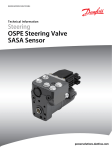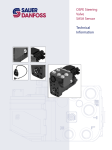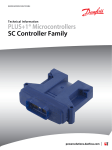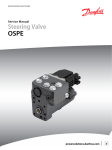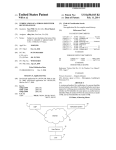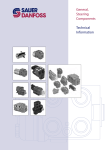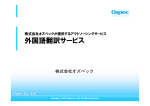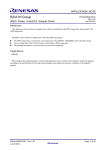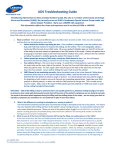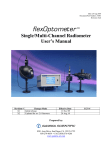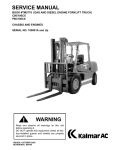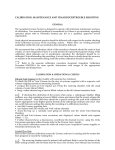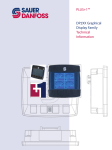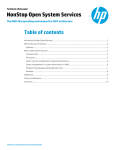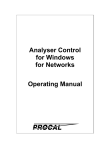Download OSPE Steering Valve Technical Information Manual
Transcript
MAKING MODERN LIVING POSSIBLE Technical Information Steering OSPE Steering Valve SASA Sensor powersolutions.danfoss.com Technical Information OSPE Steering Valve SASA Sensor Revision history Table of revisions 2 Date Changed Rev May 2015 Dimension drawing updated DB July 2014 Changed to Danfoss layout DA July 2011 Flow characteristics added CA October 2009 Major change BA August 2009 First edition AA 11068682 • Rev DB • May 2015 Technical Information OSPE Steering Valve SASA Sensor Contents A wide range of Steering Components For hydrostatic steering systems Danfoss offers:................................................................................................................. 5 For electrohydraulic steering systems Danfoss offers:....................................................................................................... 6 Characteristic features for steering units:................................................................................................................................6 Characteristic features for electrohydraulic steering systems with OSPE and EHPS:.............................................. 6 Conversion factors........................................................................................................................................................................... 6 Survey of literature with technical data on Danfoss Steering Components...............................................................6 General Versions General steering valve type OSPE.............................................................................................................................................. 7 Overview..............................................................................................................................................................................................8 OSPEC LSRM:...................................................................................................................................................................................... 9 OSPEF LS............................................................................................................................................................................................10 OSPEDC LSRM..................................................................................................................................................................................11 OSPEDF LS........................................................................................................................................................................................ 12 Steering valve EHPS and electrical actuation PVE for EHPS PVED-CL/CLS....................................................................................................................................................................................13 Function Technical data Dimensioning Technical characteristics Dimensions OSPE steering valve.......................................................................................................................................................................14 OSPEC LSRM.....................................................................................................................................................................................15 Neutral position.........................................................................................................................................................................15 Steering right with steering wheel.....................................................................................................................................17 Steering right with EH.............................................................................................................................................................19 PVES and PVED-CLS, electrical actuation.............................................................................................................................. 20 Closed loop control....................................................................................................................................................................... 20 Principle.............................................................................................................................................................................................20 Inductive transducer, LVDT........................................................................................................................................................ 21 Integrated pulse width modulation........................................................................................................................................21 OSPE....................................................................................................................................................................................................22 Weights..............................................................................................................................................................................................22 PVES.................................................................................................................................................................................................... 23 PVED-CLS...........................................................................................................................................................................................24 Hysteresis, PVES and PVED-CLS................................................................................................................................................ 24 PVES and PVED-CLS.......................................................................................................................................................................24 Installation PVED-CLS................................................................................................................................................................... 25 Coil of control valve for mode select...................................................................................................................................... 25 Specifications............................................................................................................................................................................. 25 Electrical specifications...........................................................................................................................................................26 Terminals..................................................................................................................................................................................... 26 Dimensioning steering system with OSPE steering valve...............................................................................................28 EH-directional spools of OSPE................................................................................................................................................... 29 Pilot pressure relief valve: (P - T, Qp) characteristic........................................................................................................... 29 Pressure drop P-EF for Danfoss OSPE valve..........................................................................................................................30 OSPE dimensions........................................................................................................................................................................... 31 Hydraulic systems System safety Emergency steering...................................................................................................................................................................... 35 OSPE and system safety PVES ...................................................................................................................................................35 Fault monitoring....................................................................................................................................................................... 35 Passive fault monitoring........................................................................................................................................................ 35 11068682 • Rev DB • May 2015 3 Technical Information OSPE Steering Valve SASA Sensor Contents Safety considerations................................................................................................................................................................... 36 On-road operation................................................................................................................................................................... 36 Order specification Sensor type SASA 4 Variants and order specification...............................................................................................................................................37 Code numbers.................................................................................................................................................................................38 Sensor type SASA general...........................................................................................................................................................39 Versions, code numbers and weights for SASA sensor.................................................................................................... 39 Code number and weight, SAK adapter kit.......................................................................................................................... 39 CAN message protocol................................................................................................................................................................ 40 Parameter setup............................................................................................................................................................................. 40 Technical data................................................................................................................................................................................. 41 Mechanical.................................................................................................................................................................................. 41 Electrical.......................................................................................................................................................................................41 Output.......................................................................................................................................................................................... 41 Safety function...........................................................................................................................................................................41 Environmental........................................................................................................................................................................... 41 Dimensions SASA sensor.............................................................................................................................................................42 SAK adapter kit................................................................................................................................................................................42 Installation........................................................................................................................................................................................ 42 Recommended wiring practice........................................................................................................................................... 44 11068682 • Rev DB • May 2015 Technical Information OSPE Steering Valve SASA Sensor A wide range of Steering Components Danfoss is one of the largest producers in the world of steering components for hydrostatic steering systems on off-road vehicles. Danfoss offers steering solutions both at component and system levels. Our product range makes it possible to cover applications of all types - ranging from ordinary 2-wheel steering (also known as Ackermann steering) to articulated steering, automatic steering (e.g. by sensor) and remote controlled steering via satellite. We can offer more than 1,800 different steering units and 250 different priority valves categorized in types, variants and sizes. For hydrostatic steering systems Danfoss offers: • • • • • Mini steering units with displacements from 32 to 100 cm3/rev [1.95 to 6.10 in3/rev], flow up to 20 l/min [5.28 US gal/min], steering pressure up to 140 bar [2030 psi]. Steering units with displacements from 40 to 1200 cm3/rev [2.44 to 73.2 in3/rev], flow up to 100 l/min [26.4 US gaL/min, steering pressure up to 240 bar [3481 psi]. Priority valves for rated flows at 40, 80, 120, 160 and 320 l/min [10.6, 21.1, 31.7, 42.3 and 84.5 US gal/ min], pressure up to 350 bar [5076 psi]. Pilot operated flow-amplifiers with amplification factors of 4, 5, 8, 10 or 20 for rated oil flows of 240 and 400 l/min [63.4 and 105.7 US gal/min], steering pressure up to 210 bar [3045 psi]. Pilot operated steering valve with steering flow up to 100 l/min [26.4 US gal/min], steering pressure up to 250 bar [3625 psi] and with integrated priority valve for pump flow up to 120 l/min [31.7 US gal/ min]. 11068682 • Rev DB • May 2015 5 Technical Information OSPE Steering Valve SASA Sensor A wide range of Steering Components For electrohydraulic steering systems Danfoss offers: • • Pilot operated steering valves (pilot operated by hydrostatic steering unit or by electrical signal) with steering flows up to 100 l/min [26.4 US gal/min], steering pressure up to 250 bar [3625 psi]. Steering units with integrated electrical operated steering valve with steering flow up to 50 l/min [13.2 US gal/min], steering pressure up to 210 bar [3045 psi]. Characteristic features for steering units: • • • • • • Low steering torque: From 0.5 N•m to 3 N•m in normal steering situations Low noise level Low pressure drop Many types available: Open center Non-reaction, Open center Reaction, Power Beyond, Closed center Non-reaction, Load Sensing, Load Sensing Reaction One or more built-in valve functions: relief valve, shock valves, suction valves, non-return valve in Pline and in LS-line Optional port connections (according to ISO, SAE or DIN standards) Characteristic features for electrohydraulic steering systems with OSPE and EHPS: • • • • • Possibility of GPS, row sensor, variable steering ratio and joystick steering The possibility of manual steering even on very heavy vehicles EHPS: High steering pressure requiring smaller cylinders and flow EHPS: Low pilot pressure and flow giving extremely low noise in the cabin EHPS: Can be combined with Danfoss PVG 32 proportional valve Conversion factors 1 N•m = [8.851 lbf•in] 1 l = [0.264 US gal] 1 N = [0.2248 lbf] 1 bar = [14.5 psi] 1 mm = [0.0394 in] °F = [1.8°C + 32] 1 cm3 = [0.061 in3] Survey of literature with technical data on Danfoss Steering Components Detailed data on all Danfoss steering components and accessories can be found in our steering component catalogues, which is divided in to the following individual sub catalogues: General information Steering components Technical data on mini steering units OSPM Technical data on open center, and closed center steering units OSPB, OSPC, and OSPD Technical data on load sensing steering units, priority valves and flow amplifiers OSPB, OSPC, OSPF, OSPD, OSPL, OSPBX, OSPLX, OVPL, OLS and OSQ Technical data on hydraulic and electrohydraulic pilot operated steering valves, electrical actuation modules and appropriate steering units. EHPS, EHPS w. OLS 320, PVE for EHPS and OSPCX Technical data on combined steering unit/electrohydraulic steering valves and steering wheel sensors OSPE and SASA Technical data on load sensing steering unit with amplification OSPU For technical information on individual variants, please contact the Danfoss Sales Organization. 6 11068682 • Rev DB • May 2015 Technical Information OSPE Steering Valve SASA Sensor General General steering valve type OSPE On tractors, combine harvesters, maize harvesters and other simulate vehicles there is often a need for electrically actuated steering to make automatic GPS controlled steering possible. Also manual steering with variable ratio is an often wanted feature to improve productivity and driver comfort. For this purpose Danfoss has developed a combined steering unit and electro hydraulic steering valve named OSPE: OSP for normal manual steering wheel activated steering and E for electro hydraulic steering activated by electrical input signal either from GPS or vehicle controller or from steering wheel sensor (Danfoss type SASA) for variable steering ratio. In variable steering mode, the electro hydraulic valve part adds flow to the metered out flow from the steering unit part of the OSPE. OSPE has build in safety function in form of cut off valve, which makes unintended steering from Electro hydraulic valve part impossible. So OSPE is the right steering element first of all to build up steering system with very high safety level and so to be able to fulfill legislations demands like e.g. demands in EU Machinery Directive 2006/42/EC In cases where space do not allow room enough for OSPE, an ordinary OSP non-reaction steering unit combined the EH-Electro Hydraulic In-Line steering valve is an alternative. EH valves are offered with the same safety functions as OSPE. Please contact Danfoss sales organisation. 11068682 • Rev DB • May 2015 7 Technical Information OSPE Steering Valve SASA Sensor Versions Overview Steering valve OSPE and electrical actuation module PVE Steering unit part Version Spool/sleeve type Gear set OSPEC xxx LSRM “C”-dynamic, LSRM, Load Sensing, Reaction Single OSPEF xxx LS “F”-dynamic, LS, Non-Reaction Single OSPEDC xx/yyy LSRM “C”-dynamic, LSRM, Load Sensing, Reaction Dual OSPEDF xx/yyy LS “F”-dynamic, LS, Non-Reaction Dual EH-part of OSPE in combination with any OSPE Spool type PVE actuator Static PVES, PVED CC, PVED CLS Priority valve in OSPE in combination with any OSPE 8 Spool type Note Dynamic If priority valve is present elsewhere in system, OSPE can be w.o. priority valve. 11068682 • Rev DB • May 2015 Technical Information OSPE Steering Valve SASA Sensor Versions OSPEC LSRM: This version is preferred for front wheel steered vehicles, like e.g. tractors, where self-alignment steering effect is desired. Reaction type steering resembles a car where the direction of travel will continue straight ahead when ever the steering wheel is not touched. The reaction concept in any OSPE steering units is based on Danfoss RM technology. The reaction effort is selectable by help of the solenoid valve for activating EH steering: • Road mode: When EH steering is powered off, then OSPE behaves the same as a Reaction unit • Field mode: When EH steering is powered on, then OSPE behaves the same as a Non-reaction unit OSP R L Rr Lr LS P EH PVE Electronics PE TE LS P EF T L R P301 168 11068682 • Rev DB • May 2015 9 Technical Information OSPE Steering Valve SASA Sensor Versions OSPEF LS This version is preferred for rear wheel steered vehicles, like e.g. combines. In both modes: Road mode: When EH steering is un powered • • Field mode: When EH steering is powered the steering unit part behaves as a Non-reaction steering unit. The “F”-spool type is preferred for steering systems where high level of negative steering forces may be present e.g. articulated steered vehicles. OSP L Rr Lr R LS P EH PVE Electronics PE TE LS P 10 11068682 • Rev DB • May 2015 T L R P301 170 Technical Information OSPE Steering Valve SASA Sensor Versions OSPEDC LSRM This version is preferred for front wheel steered vehicles, like e.g. tractors, where self-alignment steering effect is desired. Only difference compared to OSPEC LSRM is that “D” type has 2 gear wheel sets (rotary meters). Should the pump supply be lost, only one gear set is active for emergency steering. In normal steering situations both gear sets are active. OSP L Rr Lr R LS P EH PVE Electronics PE TE LS P 11068682 • Rev DB • May 2015 EF T L R P301 171 11 Technical Information OSPE Steering Valve SASA Sensor Versions OSPEDF LS This version is preferred for rear wheel steered and articulated vehicles. Only difference compared to OSPEF LS is that “D” type has 2 gear wheel sets (rotary meters). This version however is shown without priority valve. OSP L R LS P EH PVE Electronics PE TE LS P 12 11068682 • Rev DB • May 2015 T L R P301 172 Technical Information OSPE Steering Valve SASA Sensor Steering valve EHPS and electrical actuation PVE for EHPS PVED-CL/CLS PVED-CL must not be promoted any longer. PVED-CL will be replaced by PVED-CLS by the end of 2014. Please contact Danfoss Sales Organization for further details. OSPE with an electrical programmable module (PVED-CLS) the following steering features in electro hydraulic steer mode/field mode are possible: • GPS-steering • • • • Row sensor/ camera steering Joy stick or mini st. wheel steering Variable steering ratio Speed depending steering ratio 11068682 • Rev DB • May 2015 13 Technical Information OSPE Steering Valve SASA Sensor Function OSPE steering valve 18 9, 10, 11 8 14, 15, 17 16 7 21 13 12 2 22 1 3 5 P301 216 The OSPE steering valve includes the following main components 1 2 3 5 7 8 9 10 11 14 Shock valves Suction valves Spool/sleeve set Gear set Mode select and EH cut off valve EH directional valve PVE control unit LVDT transducer Solenoid valve bridge 11068682 • Rev DB • May 2015 12 13 14 15 16 17 18 21 22 Control valve for mode select Pilot reduction valve, 12 bar PP damping orifice Priority valve spool Priority valve spring Dynamic orifice Pilot pressure relief valve PVFC valve/LS resolver Neutral spring package for spool/sleeve Technical Information OSPE Steering Valve SASA Sensor Function OSPEC LSRM Neutral position 1 OSP 2 L R 3 4 22 5 6 7 Rr Lr LS P EH 8 PVE 9 Electronics 10 21 11 20 PE CF 19 TE 12 13 LS P 14 1 2 3 4 5 6 7 8 9 10 11 15 EF 16 Shock valves Suction valves Spool/sleeve set Emergency steering check valve Gear set P-check valve Mode select and EH cut off valve EH directional valve PVE control unit LVDT transducer Solenoid valve bridge T L R 17 P301 173 18 12 13 14 15 16 17 18 19 20 21 22 Control valve for mode select Pilot reduction valve, 12 bar PP damping orifice Priority valve spool Priority valve spring Dynamic orifice Pilot pressure relief valve LS orifice LS check valve PVFC valve/LS resolver Neutral spring package for spool/sleeve When the engine is turned off, the priority valve spool (15) is pushed to the left by the spring (16). The passage to the EF port is blocked and the passage to CF to the OSP spool/sleeve set (3) and to the EH directional valve spool (8) is open. 11068682 • Rev DB • May 2015 15 Technical Information OSPE Steering Valve SASA Sensor Function When the engine is on and the steering unit OSP and EH is in neutral position, the CF pressure will rise to match the spring force in the priority valve, and the priority valve spool (15) will move to the right and the oil will pass from the pump across the integrated priority valve spool (15) and out through the EF port. The priority valve is a “dynamic” type, meaning that a flow passes from CF through the Dynamic orifice (17) (integrated in spool 15) and into the LS line through the LS orifice (19), LS check valve (20), the PVFC valve (21) and into the spool/sleeve set (3). In neutral position this dynamic oil flow passes on to the tank. When the steering unit is in neutral position and control valve (12) is deactivated, then the mode select/EH cut off valve (7) makes connection through the Reaction circuit, Lr and Rr. So if the steering wheel is untouched and a delta P is generated in the steering cylinder, oil will pass from L to R or R to L through the spool/sleeve set (3) and gear set (5) and the steering wheel will rotate until it is grabbed or delta P disappears. Only the force of the neutral spring package (22) has to be overcome to stop the rotation of the steering wheel and therefore stop the cylinder movement. The mode select/EH cut off valve (7) makes unintended EH steering impossible, if e.g. a false input signal comes to the PVE control unit (9), when the control valve (12) is deactivated, because L and R connections from EH directional valve spool (8) are blocked in (7). If the control valve (12) is activated, then the mode select/EH cut off valve (7) blocks connection through the Reaction circuit. In this position there will be no reaction behavior even if there is build up delta P on the steering cylinder from forces on the steered wheels. So the steering unit behaves as a Non reaction OSP. In that situation (If the control valve (12) is activated) EH steering is possible. 16 11068682 • Rev DB • May 2015 Technical Information OSPE Steering Valve SASA Sensor Function Steering right with steering wheel 1 OSP 2 L R 3 4 22 5 6 7 Rr Lr LS P EH 8 PVE 9 Electronics 10 21 11 20 PE CF 19 TE 12 13 LS EF P 14 1 2 3 4 5 6 7 8 9 10 11 15 16 Shock valves Suction valves Spool/sleeve set Emergency steering check valve Gear set P-check valve Mode select and EH cut off valve EH directional valve PVE control unit LVDT transducer Solenoid valve bridge T L R 17 P301 174 18 12 13 14 15 16 17 18 19 20 21 22 Control valve for mode select Pilot reduction valve, 12 bar PP damping orifice Priority valve spool Priority valve spring Dynamic orifice Pilot pressure relief valve LS orifice LS check valve PVFC valve/LS resolver Neutral spring package for spool/sleeve When steering with the steering wheel to the right, the spool of the spool/sleeve set (3) will rotate relative to the sleeve. So LS line will be connected to R-side. LS pressure will raise accordingly to steering pressure required and priority valve spool (15) will be pressed to the left and oil will stream through the internal CF side of the priority valve and on to the spool/sleeve set (3) through the gear set (5) and out through the R connection. In parallel the L side is opened through the spool/sleeve set (3) to tank (T). When steering up against cylinder end stop, pressure will raise in LS line according to setting of pilot 11068682 • Rev DB • May 2015 17 Technical Information OSPE Steering Valve SASA Sensor Function pressure control valve (18). Check valve (20) avoids oil to stream backwards from servo side (R in this case) and over valve (18) to tank. So the valve (18) shall only open for the dynamic flow generated in the dynamic orifice (17) of priority valve part, independent if steering is done by the steering wheel (OSP part) or by the EH valve. 18 11068682 • Rev DB • May 2015 Technical Information OSPE Steering Valve SASA Sensor Function Steering right with EH 1 OSP 2 L R 3 22 4 5 6 7 Rr Lr LS P EH 8 PVE 9 Electronics 21 10 11 20 PE CF 19 TE 12 13 LS P 14 1 2 3 4 5 6 7 8 9 10 11 15 EF 16 Shock valves Suction valves Spool/sleeve set Emergency steering check valve Gear set P-check valve Mode select and EH cut off valve EH directional valve PVE control unit LVDT transducer Solenoid valve bridge T L R 17 P301 175 18 12 13 14 15 16 17 18 19 20 21 22 Control valve for mode select Pilot reduction valve, 12 bar PP damping orifice Priority valve spool Priority valve spring Dynamic orifice Pilot pressure relief valve LS orifice LS check valve PVFC valve/LS resolver Neutral spring package for spool/sleeve Before it is possible to steer with the EH part of the OSPE, it is needed to power the control valve for mode select (12) for field mode. When this valve is powered, the pilot supply (12 bar) is lead from the pilot reduction valve (13) through the control valve (12) to the solenoid valve bridge (11) of the PVE control unit (9) and in parallel to the mode select and EH cut off valve (7). So the valve (7) makes connection from EH directional valve (8) to the cylinder ports, L and R. In the same shift, the valve (7) 11068682 • Rev DB • May 2015 19 Technical Information OSPE Steering Valve SASA Sensor Function interrupts the reaction circuit, Lr and Rr, from the spool/sleeve set (3) to the cylinder ports, and the unit acts as a non-reaction OSP in this mode. When an input signal is transmitted to the electrical connector of the PVE (9), in this example signal to steer to the right, the solenoid valve bridge (11) is activated and the EH directional valve spool (8) is moved to the right. So LS in the spool (8) will sense the needed steering pressure, and this is transmitted to the PVFC valve /LS resolver (21). So the valve (21) makes restrictions in the dynamic LS flow from dynamic orifice (17) of priority valve, and the LS pressure in the priority valve spool (15) will match the LS pressure required from the EH directional valve spool (8). Accordingly the position of the priority valve spool (15) will change to match the flow demand for EH-steering. In case an external “watch dog” registers an unintended steering movement e.g. due to a false input signal to the PVE, the electrical power to the control valve for mode select (12) must be switched off. This must be controlled by the “watch dog”. So valve 12 will dump pilot pressure to tank, mode select and EH cut off valve (7) will change position so that connection from EH directional valve spool (8) to cylinder ports will be blocked. Furthermore it will not be possible to activate the solenoid valve bridge (11) and the PVE will go into/stay in neutral position. In this way a true safe state is established. The non-reaction circuit from the OSP part is always connected to L and R cylinder ports independent of position of mode select valve (7), and so OSP steering is always possible. PVES and PVED-CLS, electrical actuation The philosophy of Danfoss electro hydraulic actuation, type PVE, is integration of electronics, sensors and actuators into a single unit that interfaces directly to the OSPE steering valve body. Closed loop control All the proportional actuators feature an integrated feedback transducer that measures spool movement in relation to the input signal, and by means of a solenoid valve bridge, controls the direction, velocity and position of the directional spool of the valve. The integrated electronics compensate for flow forces on the spool, internal leakage, changes in oil viscosity, pilot pressure, etc. This results in lower hysteresis and better resolution. Furthermore the electronics enable built in safety like fault monitoring, directional indication and LED light indication. Principle In principle the input signal (set-point signal) determines the level of pilot pressure which moves the main spool. The position of the directional spool is sensed in the LVDT transducer which generates an 20 11068682 • Rev DB • May 2015 Technical Information OSPE Steering Valve SASA Sensor Function electric feed-back signal registred by the electronics. The variation between the set-point signal and feedback signal actuates the solenoid valves. The solenoid valves are actuated so that hydraulic pilot pressure drives the directional spool into the correct position. Inductive transducer, LVDT (Linear Variable Differential Transformer). When the directional spool is moved, a voltage is induced proportional to the spool position. The use of LVDT gives contact-free monitoring of the directional spool position. This means an extra-long working life and no limitation as regards the type of hydraulic fluid used. In addition, LVDT gives precise position signal of high resolution. Integrated pulse width modulation Positioning of the directional spool in PVES is based on the pulse width modulation principle. As soon as the directional spool reaches the required position, modulation stops and the spool is locked in position. 11068682 • Rev DB • May 2015 21 Technical Information OSPE Steering Valve SASA Sensor Technical data OSPE The technical data for OSPE are typical measured results. For the hydraulic system a mineral based hydraulic oil with a viscosity of 21 mm2/s [102 SUS] and a temperature of 50°C [122°F] was used. Single, range 100-500 cm3/rev [6.1-30.5 in3/rev] Dual, range 60/120 – 125/440 cm3/rev [3.7/7.3 – 7.6/26.8 in3/rev] Port P, EF 250 bar [3625 psi] Port LS 210 bar [3045 psi] Port L, R 280 bar [4060 psi] Port T 25 bar [362 psi] Port P, EF 90 l/min [23.8 US gal/min] Port L/R, steering wheel steering 50 l/min [12.2 US gal/min] Port L/R, EH steering 12, 20, 30 or 40 l/min [3.2, 5.3, 7.9 or 10.6 US gal/ min] Spool travel, EH directional spool ± 4 mm [± 0.16 in] Dead band, EH-directional spool, nominal ± 0.8 mm [± 0.03 in] Priority valve Type Dynamic Spring force 7 bar, 10 bar optional [100 psi, 145 psi optional] Nominal flow 90 l/min [23.8 US gal/min] Recommended temperature 30 --> +60°C [86 --> +140°F] Min. temperature -30°C [-22°F] Max. temperature +90°C [190°F] Gear set Max. pressure Oil flow rated Oil temperature Ambient temperature Oil viscosity -30 --> +60°C [-22 --> +140°F] Operating range 12-80 mm2/sec [66.0-370.3 SUS] Min. viscosity 10 mm2/sec [58.9 SUS] [2134 SUS] Max. viscosity 460 mm2/sec Filtration Max contamination (ISO 4406) 21/19/16 Temperature difference between steering unit and other hydraulics Max. 10°C [50°F] Weights Weight of OSPE Type 22 Weight kg [lb] OSPE 100 12.7 [28.0] OSPE 125 12.8 [28.2] OSPE 140 12.9 [28.4] OSPE 160 13.0 [28.7] OSPE 185 13.1 [28.9] OSPE 200 13.2 [29.1] 11068682 • Rev DB • May 2015 Technical Information OSPE Steering Valve SASA Sensor Technical data Weight of OSPE (continued) Type Weight OSPE 230 kg [lb] 13.5 [29.8] OSPE 250 13.4 [29.5] OSPE 315 13.7 [30.2] OSPE 400 14.1 [31.1] OSPE 430 14.2 [31.3] OSPE 500 14.5 [32.0] Weight of OSPED Type Weight kg [lb] OSPED 60/120 14.6 [32.2] OSPED 60/220 15.2 [33.5] OSPED 70/170 14.8 [32.6] OSPED 70/320 15.5 [34.2] OSPED 80/240 15.1 [33.1] OSPED 80/395 15.8 [34.8] OSPED 100/260 15.2 [33.5] OSPED 100/300 15.4 [34.0] OSPED 125/285 15.3 [33.7] OSPED 125/440 16.0 [35.3] PVES PVES Supply voltage UDC rated 11 V to 32 V range 11 V to 32 V max. ripple 5% Current consumption at rated voltage PVES Signal voltage 0.57 A @ 12 V neutral 0.5 x UDC CR-port ↔ CL-port 0.25 • UDC to 0.75 • UDC Signal current at rated voltage 0.25 mA to 0.70 mA Input impedance in relation to 0.5 • UDC 12 KΩ Input capacitor 100 ηF Power consumption PVES 7W 11068682 • Rev DB • May 2015 0.3 A @ 24 V 23 Technical Information OSPE Steering Valve SASA Sensor Technical data Supply voltage Function Disconnected by means of neutral switch Reaction time from neutral position to max. spool travel Disconnected by means of neutral switch Constant voltage PVES Prop. super s Reaction time from max. spool travel to neutral position Reaction time from neutral position to max. spool travel Constant voltage Reaction time from max. spool travel to neutral position max. 0.230 rated 0.150 min. 0.120 max. 0.175 rated 0.090 min. 0.065 max. 0.200 rated 0.120 min. 0.050 max. 0.100 rated 0.090 min. 0.065 PVED-CLS Information is under preparation. Hysteresis, PVES and PVED-CLS Hysteresis, PVES and PVED-CLS1) ∼ 0% rated 1) Hysteresis is indicated at rated voltage and f = 0.02 Hz for one cycle (one cycle = neutral -> full CL -> full CR -> neutral. Spool travel 157-669.11 PVES and PVED-CLS Oil consumption 24 Supply voltage Function Without voltage Pilot oil flow neutral 0.3 l/min [0.078 US gal/min] With voltage Pilot oil flow locked 0.1 l/min [0.026 US gal/min] continuous actuations 0.8 l/min [0.211 US gal/min] 11068682 • Rev DB • May 2015 PVES and PVED-CLS Technical Information OSPE Steering Valve SASA Sensor Technical data Oil viscosity Oil viscosity range 12 - 75 mm2/s [65 - 347 SUS] min. 4 mm2/s [39 SUS] max. 460 mm2/s [2128 SUS] Rec. range 30 - 60˚C [86 -140˚F] min. -30˚C [-22˚F] max. 90˚C [194˚F] Note: Max. start up viscosity 2500 mm2/s Oil temperature Oil-temperature Filtering Filtering in the hydraulic system Max. allowed degree of contamination (ISO 4406, 1999 version): 23/19/16 Ambient temperature Ambiant temperatur range Rec. -30° → +60°C [-22° → +140°F] nom. 13.5 bar [196 psi] min. 10 bar [145 psi] max. 15 bar] [217 psi] Pilot pressure Pilot pressure (relative to T pressure) Enclosure and connector version Version of connector AMP JPT connector Deutsch® connector Grade of enclosure1) IP 66 IP 67 1) According to the international standard IEC 529 In particulary exposed applications, protection in the form of screening is recommended. Installation PVED-CLS Information is under preparation. Coil of control valve for mode select Below technical data are valid for coil of control valve for mode select, when this coil is connected directly to the wiring of the application. For OSPE with PVED-CLS the coil will be connected to the PVED-CLS, further technical data will be added. Specifications • • • • Duty cycle rating: 100% Magnet wire insulation: Class H (180C) Ambient temperature: -30 to 60 ;°C [-22 to 140 °F] Diodes are available; contact your Danfoss representative. 11068682 • Rev DB • May 2015 25 Technical Information OSPE Steering Valve SASA Sensor Technical data • • • Ambient Temperature (deg C ) Environmental protection: IP65 Input voltage tolerance: ±10% All AC coils are internally rectified D08 16 watt coil 100 90 80 Minimum pull-in 70 voltage Maximum 60 operating limit 50 40 30 20 10 0 -10 -20 70% 80% 90% 100% 110% 120% 130% 140% Percent Rated Voltage P103 948E Electrical specifications 16 watt coils Voltage (V) Resistance (Ohms) ±5% @ 20 °C [72 °F] Current draw (A) at 25 °C [77 °F] Color 12 VDC 9 1.33 Gray Terminals Amp Junior Timer Code AJ 56.6 [2.23] P102 541 Part number 26 Voltage (V) Power (W) Part number 12 VDC 16 D08-16-12D-AJ 11068682 • Rev DB • May 2015 Technical Information OSPE Steering Valve SASA Sensor Technical data Deutsch® Code DE 45.2 [1.78] 60.7 [2.39] P102 538 Part number Voltage (V) Power (W) Part number 12 VDC 16 D08-16-12D-DE 11068682 • Rev DB • May 2015 27 Technical Information OSPE Steering Valve SASA Sensor Dimensioning Dimensioning steering system with OSPE steering valve The cylinder flow is determined from steering cylinder volume, number of revolutions on steering wheel from lock to lock and steering speed. Dimension of steering cylinder(s) can be based on formulas in “General, steering components” page 29-31. Symbols: V (l) steering cylinder volume i (rev) number of steering wheel revolutions from lock to lock Vvc (cm3/rev.) steering system displacement for steering cylinder CQ (l/min) nominal cylinder flow Pems (bar) emergency steering pressure Tems (Nm) emergency steering torque Fe (N) emergency steering wheel rim force Swd (m) steering wheel diameter Vvs (cm3/rev) displacement, steering unit PQ (l/min) pilot flow Qpm (l/min) pump flow, minimum Example: Cylinder volume: V = 1.85 l [0.49 US gal] Required number of steering wheel revolutions from lock to lock: i = 4 – 5 revolutions The required steering system displacement for steering cylinder is calculated from Vvc = V/i = (1.85*1000)/5 = 370 cm3/rev [22.58 in3/rev] (1.85*1000)/4 = 463 cm3/rev [28.25 in3/rev] In this example we chose Vvc = 400 cm3/rev [24.4 in3/rev] The nominal cylinder flow at 100 rpm speed on steering wheel. CQ = 400 * 100/1000 (cm3/l) = 40 l/min [10.57 US gal/min]In this case we try to use an “D” type steering unit to avoid emergency steering pump. The “small” gear set, which is the only hydraulically active gear set in emergency steering mode is determined by the demand for emergency steering pressure, look in “General , steering components” page 28-29. Emergency steering pressure, Pems, is calculated to be maximum Pems = 40 bar [580 psi] Maximum allowable steering torque Tems based on steering wheel rim force Fe=350 N and steering wheel diameter Swd = 0.381 m Tems = Fe * Swd/2 = 350 * 0.381/2 = 66.7 Nm [580 lbf•in] Emergency steering unit displacement can be chosen/calculated from the table lowest on page 29 in “General, steering components”. The nearest displacement Vvs generating minimum 40 bar [580 psi]at Tws = 66.7 N•m [580 lbf•in] Vvs maximum = 80 cm3/rev [4.88 in3/rev] So the closest combination on gear sets for this OSPED type will be: 80/395. So the numbers of steering wheel revolutions from lock to lock will be. i = V/Vvc = 1850/395 = 4.7 turns lock to lock. 28 11068682 • Rev DB • May 2015 Technical Information OSPE Steering Valve SASA Sensor Technical characteristics EH-directional spools of OSPE Cylinder flow characteristic for directional spools Q l/min 45 D US gal/min D 40 10 35 C C 30 7.5 25 B B 20 5 15 A A 10 2.5 5 -4 -3 -2 -1 0 1 2 3 -580 -492 -328 -164 0 164 328 492 580 Can 0.43 0.46 0.5 0.54 0.57 0.60 0.65 Us/U DC L 0.35 0.40 4 mm R P301 220 A= valid for spools for nominal cylinder flow CQ = 12 l/min [3.17 US gal/min] B= valid for spools for nominal cylinder flow CQ = 20 l/min [5.28 US gal/min] C= valid for spools for nominal cylinder flow CQ = 30 l/min [7.97 US gal/min] D= valid for spools for nominal cylinder flow CQ = 40 l/min [10.57 US gal/min] The curves are valid for OSPE with internal priority valve w. 7 bar [100 psi] spring and 1.0 mm [0.039 in] dynamic orifice and @ 60 l/min [15.85 US gal/min] pump flow. For OSPE without internal priority valve, the curves are valid in combination with external priority valve OLS 80, 152B8269 @ 60 l/min [15.85 US gal/min] pump flow. Pilot pressure relief valve: (P - T, Qp) characteristic The pilot pressure relief valve protects the steering system against excessive pressure. The pilot pressure relief valve works together with the priority valve in the OSPE to limit the maximum steering pressure P-T. The pilot pressure relief valve is set at an oil flow to the priority valve of 25 l/min [6.6 US gal/min]. Setting tolerance: rated value +10 bar [145 psi]. 11068682 • Rev DB • May 2015 29 Technical Information OSPE Steering Valve SASA Sensor Technical characteristics P-T P-T psi bar 250 3500 3000 200 bar [2900 psi] 170 bar [2465 psi] 140 bar [2030 psi] 200 2500 150 2000 1500 100 1000 50 500 0 Qp 0 10 20 30 40 50 60 70 80 l/min 90 Qp 0 5 10 15 US gal/min 20 V301 217 Pressure drop P-EF for Danfoss OSPE valve This data comes from measurements on a representative sample of OSPE valves from production. Oil with viscosity of 21 mm2/s at 50 °C was used during measuring. Measurement is made when the pressure on the LS connection is zero. The minimum curve applies when the pressure on the EF connection is higher than the actual control spring pressure. The curve for control spring pressure of 7 bar [100 psi] and 10 bar [145 psi] applies when pressure on the EF port is zero. OSPE with priority valve spool P-EF psi P-EF bar 16 200 10 bar [145 psi] 7 bar [102 psi] min. 14 12 150 10 8 100 6 50 4 2 0 0 0 0 10 20 5 30 40 10 50 60 15 70 80 20 90 Qp l/min Qp US gal/min P301 218 30 11068682 • Rev DB • May 2015 Technical Information OSPE Steering Valve SASA Sensor Dimensions OSPE dimensions OSPE 127 111 71.5 ∅44.4 ±0.05 2.8 55.5 111 51 min. 7.1 L2 213 L1 92 77 65 37 31 27 7 18 ∅25.4 157 OSPED 45° 142 L3 ∅8 2 L2 ±0 .3 L1 A P301 176.11 Metric-port version (ISO 6149-1): P, T, EF: M22 x 1.5, 15 mm deep L, R: M18 x 1.5, 14.5 mm deep LS: M12 x 1.5, 11.5 mm deep A: 4x M10 x 1.5, 16 mm deep OSPE dimensions Type L1 L2 mm [in] mm [in] OSPE 100 140 [5.51] 13.0 [0.51] OSPE 125 143 [5.63] 16.2 [0.64] OSPE 140 146 [5.75] 18.6 [0.73] OSPE 160 148 [5.83] 20.8 [0.82] OSPE 185 151 [5.94] 24.0 [0.95] OSPE 200 153 [6.02] 26.0 [1.02] OSPE 230 162 [6.38] 35.1 [1.38] OSPE 250 160 [6.30] 32.5 [1.28] 11068682 • Rev DB • May 2015 31 Technical Information OSPE Steering Valve SASA Sensor Dimensions OSPE dimensions (continued) Type OSPE 315 L1 L2 mm [in] mm [in] 168 [6.61] 40.9 [1.61] OSPE 400 179 [7.05] 52.0 [2.05] OSPE 430 183 [7.20] 55.9 [2.20] OSPE 500 192 [7.56] 65.0 [2.56] OSPED dimensions Type 32 L1 L2 L3 mm [in] mm [in] mm [in] OSPED 60/120 193 [7.60] 9.1 [0.36] 9.1 [0.36] OSPED 60/220 205 [8.07] 9.1 [0.36] 20.8 [2.39] OSPED 70/170 197 [7.76] 9.1 [0.36] 13.0 [0.51] OSPED 70/320 216 [8.50] 9.1 [0.36] 32.5 [1.28] OSPED 80/240 206 [8.11] 10.4 [0.41] 20.8 [0.82] OSPED 80/395 226 [8.90] 10.4 [0.41] 40.9 [1.61] OSPED 100/260 209 [8.23] 13.0 [0.51] 20.8 [0.82] OSPED 100/300 214 [8.43] 13.0 [0.51] 26.0 [1.02] OSPED 125/285 212 [8.35] 16.2 [0.64] 20.8 [0.82] OSPED 125/440 232 [9.13] 16.2 [0.64] 40.9 [1.61] 11068682 • Rev DB • May 2015 Technical Information OSPE Steering Valve SASA Sensor Hydraulic systems OSPE in a system with fixed gear pump and GPS steering GPS OSP L Display R Watchdog controller SASA Rr Lr LS P EH PVE Electronics PE TE LS P EF T L R P301 177 Prime mover Working Hydraulic OC The pump, the OSPE priority valve part and the working hydraulics must be protected by a separate pressure relief valve.The vehicle controller/watch dog monitors input from the GPS, steering angle sensor (SASA) and signal from steering cylinder sensor. In case of unintended movement from the cylinder sensor, the watch dog shall remove power to the control valve for mode select/pilot dump, and in this way electro hydraulic actuation of steering cylinder is made impossible. The system turns into true safe mode. 11068682 • Rev DB • May 2015 33 Technical Information OSPE Steering Valve SASA Sensor Hydraulic systems OSPE in a system with variable pump and GPS steering GPS OSP L Display R Watchdog controller SASA Rr Lr LS P EH PVE Electronics PE TE LS P EF AUX T L R P301 178 Prime mover Working Hydraulic CC The pump must have a built in pilot pressure relief valve to protect the OSPE, the priority valve part, the working hydraulics and the AUX function. AUX can be a brake system, which must have limited oil consumption to ensure steering capability in any case. Alternative pressure protection must be present in working and in AUX-hydraulic. 34 11068682 • Rev DB • May 2015 Technical Information OSPE Steering Valve SASA Sensor System safety Emergency steering The steering unit part of the OSPE acts like any other OSP steering units in case of no pump supply. In such case the gear wheel set acts as a hand driven pump, and so muscular power will be converted from input torque and rotation on the steering wheel to hydraulic power in the form of pressure and flow out of the cylinder port to which side the steering is done. See Dimensioning steering system with OSPE steering valve on page 28 in this catalog and page 28 in “General, steering components” for calculating manual/emergency steering. Please see promotional brochure 11059881 for further information. OSPE and system safety PVES Fault monitoring A fault monitoring system is provided in all PVES modules. The system is available as passive fault monitoring type, which provides a warning signal only. • Passive fault monitoring systems are triggered by three main events: 1. Input signal monitoring The PVES input signal voltage is continuously monitored. The permissible range is between 15% and 85% of the supply voltage. Outside this range the section will switch into an active error state. 2. Transducer supervision If one of the wires to the LVDT sensor is broken or short-circuited, the section will switch into an active error state. 3. Supervision of the closed loop The actual position must always correspond to the demanded position (input signal). If the actual spool position is further than the demanded spool position (>12%, ), the system detects an error and will switch into an active error state. On the other hand, a situation where the actual position is closer to neutral than that demanded will not cause an error state. This situation is considered “in control”. When an active error state occurs, the fault monitoring logic will be triggered: Passive fault monitoring • • • • A delay of 250 ms before anything happens. The solenoid valve bridge will not be disabled but still control the main spool position. An alarm signal is sent out through the appropriate pin connection, no. 3. This state is not memorized. When the erroneous state disappears, the alarm signal will turn to passive again. However, the signal will always be active for a minimum of 100 ms when triggered. To prevent the electronics from going into an undefined state, a general supervision of the power supply and the internal clock frequency is made. This function applies to PVES and will not activate fault monitoring: 11068682 • Rev DB • May 2015 35 Technical Information OSPE Steering Valve SASA Sensor System safety 1. High supply voltage The solenoid valves are disabled when the supply voltage exceeds 36 V, and the main spool will return/stay in neutral. 2. Low supply voltage: The solenoid valves are disabled when the supply voltage falls below 8.5 V, and the main spool will return/stay in neutral. 3. Internal clock The solenoid valves are disabled when the internal clock frequency fails, and the main spool will return/stay in neutral. Safety considerations On-road operation W Warning The PVES or PVED-CLS shall be de-energized while driving on-road. It is the OEMs responsibility to establish the necessary means to inform and de-energize the PVE from the cabin when driving on public roads. The Danfoss range of PVE actuators are single string designs with limited on board fault monitoring. Danfoss strongly recommends application of vehicle specific safety monitoring systems that will detect non-conforming steering and effectively disable electro-hydraulic actuators or issue appropriate warnings as the case may be. A minimum safety system should include a manual power switch to electrical power off electro-hydraulic actuators while driving on public roads. For details, see: Technical information, PVE Series 4 User Manual PVED-CL controller for Electro-Hydraulics Steering • • or contact Danfoss Technical Support Team 36 11068682 • Rev DB • May 2015 Technical Information OSPE Steering Valve SASA Sensor Order specification Variants and order specification Specification table for Danfoss OSPE steering valve. Part Variants OSP Gear set, cm3/rev Single 100, 125, 140, 160, 185, 200, 230, 250, 315, 400, 430, 500 Dual, ”D”-type 60/120, 60/185, 60/200, 60/220, 60/260, 60/290 70/140, 70/170, 70/195, 70/230, 70/270, 70/320, 70/385 80/160, 80/205, 80/240, 80/280, 80/395 100/200, 100/260, 100/300, 100/415 125/250, 125/325, 125/440 Spool/sleeve “C”-dynamic, LSRM, Load Sensing, Reaction “F”-dynamic, LS, Non-Reaction Type PVES2) PVED CC Connection AMP (A) Deutsch® (D) Coil for control valve/pilot dump Connection AMP (A) Deutsch® (D) EH-directional spool Cylinder flow, l/min 12 Priority valve With spool, nominal flow, l/min 90 Spring force, bar 7 With out spool No EF port present. P-flow determined by steering demand only Housing1) Thread Metric Relief valve Bar 100 - 210 Shock valves Bar 160 - 260 Actuation module 20 PVED CLS3) 30 40 10 2) Only available with Deutsch® 6 pin connector 3) Only available with Deutsch® 12 pin connector 1) Housing, threads: 1) Housing threads Metric, ISO 6149-1 P, T & EF L&R LS M 22 x 1.5 – O** + S** M 18 x 1.5 – O* + S**** M 12 x 1.5 – O* + S** * O-ring chamfer on port connection ** Spot face around port connection OSPEF w. displacement < 250 cc/rev. and integrated priority valve not to be used! By experience we know the combination OSPEF with displacement < 250 cc/rev. and integrated priority may cause oscillations in steering system. Therefore do not specify such combinations. We recommend using OSPEC when displacement is smaller than 250 cc and if integrated priority valve is needed. Specify your wish to the OSPE according to the destinations as in the example underneath the empty scheme: 11068682 • Rev DB • May 2015 37 Technical Information OSPE Steering Valve SASA Sensor Order specification Your wish OSPE Example OSPE D C 60/185 LSRM 20 PVES-D D 90 7 M 180 240 PB Gear set type 2) Spool/sleeve Displacement Spool/sleeve EH spool PVE Coil for ctrl. valve Priority valve 3) Prio. vlv. spring 4) Housing, thread Relief valve setting Shock valves setting Unit painted black 2) No designation for OSPE with single gear set 3) and 4) No designation for OSPE without priority valve Code numbers Code numbers for catalog versions with specifications: Code numbers Specifications according to above description format 11081352 OSPE C 100 LSRM 12 PVES-D D M 190 250 PB 11081366 OSPE C 125 LSRM 12 PVES-D D M 190 250 PB 11081367 OSPE C 160 LSRM 12 PVES-D D M 190 250 PB 11081369 OSPE C 200 LSRM 20 PVES-D D M 190 250 PB 11081388 OSPE C 250 LSRM 20 PVES-D D M 190 250 PB 11081389 OSPE C 315 LSRM 30 PVES-D D M 190 250 PB 11081390 OSPE C 400 LSRM 40 PVES-D D M 190 250 PB 11081391 OSPE C 500 LSRM 40 PVES-D D M 190 250 PB For weights, please see Weights on page 22. 38 11068682 • Rev DB • May 2015 Technical Information OSPE Steering Valve SASA Sensor Sensor type SASA Sensor type SASA general The SASA sensor detects the absolute position and speed of the steering wheel. The sensor can be used in electro-hydraulic steering systems using Danfoss EH or EHPS steering valves with programmable controller. The use of SASA sensor is relevant e.g. for variable steering ratio and closed loop set-ups where steering wheel position and steering angle have to match. SASA is based on a non-contact inductive principle giving a very high resolution. The sensor features a robust design and resists e.g. electro-magnetic radiation. The output is a CAN signal, which makes it easy to interface to advanced vehicle controllers. The steering wheel shaft turns the rotor of the SASA sensor, and the sensor is simply mounted between steering unit and steering column. The shaft of the steering column must be 15 mm longer when using SASA sensor. In cases where customers want to use the same steering column in applications with and without SASA sensors, Danfoss offers an adapter kit type SAK to built in between column and sensor. The SASA sensor offers the following features: High resolution < 0.1° • • • • • • Output CAN signal High safety, “fail silent” concept PLUS+1® Compliant Flanged in between steering unit and column Compact design Versions, code numbers and weights for SASA sensor Code number Type Supply voltage Termination resistor Cable length Connector Weigth kg [lb] 11088656 CAN 9 - 32 VDC Non 500 mm AMP code no. 2-967059-1 0.25 [0.55] 11099289 CAN 9 - 32 VDC Non 500 mm Deutsch® DT04-4P-CE02 0.25 [0.55] Code number and weight, SAK adapter kit Code number 150Z6000 11068682 • Rev DB • May 2015 Weight kg [lb] 0.8 [1.76] 39 Technical Information OSPE Steering Valve SASA Sensor Sensor type SASA CAN message protocol Interface: CAN 2.0 B Baud rate: 125 kBaud, 250 kBaud (default), 500 kBaud SASA returns cyclic the following CAN message every 5, 10 (default) or 20 ms. 301 h Data 0 Low byte ID 1 High byte Steering angle 2 3 Low byte 4 High byte Count Steering angle change 5 6 Low byte Status CRC-16 7 High byte Identifier: 301h (11 bit) Steering angle: 12 bit word (0 – 4095) relative to a 0-index point. 0 = 0 degrees 4095 = 359,912 degrees Overflow at 4095 for CW activation shall increment 0 Underflow at 0 for CCW activation shall decrement 4095 Count: byte (0-255) Increments 1 for each message Steering angle change: Difference between 2 transmitted position values in succession. 16 bit integer with 2’s complementary encoding for negative values (-32768 to 32767). -4095 = -359,912 degrees 0 = 0 degrees 4095 = 359,912 degrees Status byte 7 6 5 4 3 2 1 0 - - - - - - - Progamming mode Programming mode: Normal state is 1 Response with a 0 when starting the programming sequence (See the programming sequence described below under setup message) CRC-16: The standard CRC16 polynomial is used (x^16+x^15+x^2+1) Parameter setup Setup message: sensor can be programmed as shown in the CAN setup message below. 0C0h ID Identifier: Baud rate: Data 0 1 2 Baud rate Data rate Set 0index 3 0C0h (11 bit) Byte 0 is set to • 02h for 125 kBaud • 03h for 250 kBaud (default) • 04h for 500 kBaud during the programming sequence Data rate: Byte 1 is set to • 02h for 5 ms • 03h for 10 ms (default) • 04h for 20 ms during the programming sequence 40 11068682 • Rev DB • May 2015 4 5 Programming sequence 6 Low byte CRC-16 7 High byte Technical Information OSPE Steering Valve SASA Sensor Sensor type SASA Set 0-index: If byte 2 is set to AAh during the programming sequence, the actual angle will be stored as a reference value (0 degree) in persistent memory. Programming sequence: The following sequence is used when programming the sensor. The controller unit sends a setup message where byte 4 is set to AAh and byte 5 is set to 55h. The sensor answers with a 0 on the status byte (bit 0). The control unit then sends a setup message where byte 4 is set to 0Fh and byte 5 is set to F0h. The first and second message shall match. After receiving the last message the programming takes place in the sensor if the parameters are in the defined range, the timeout period has not been exceeded and the CRC-16 check is correct in both messages. After programming the status bit in the output message changes back from 0 to 1 Timeout period: 1s between first message from controller and response from sensor, and 1s between response from controller and second message from controller. CRC-16: The standard CRC16 polynomial is used (x^16+x^15+x^2+1) Technical data Mechanical Input range: Continuous 360° rotation Rotor torque: ≤ 0.2 N•m Expected life: > 10 million cycles Electrical Supply voltage: 9 - 32 VDC Power consumption: <1 W Output CAN V2.0B, (compatible to J1939) Termination resistor: 120 ohm (optional) Baud rate: 125, 250 or 500 kb/s Angle: 12-bit word (0 - 4095) relative to a programmable 0-index point. Resolution: < 0.1° Linearity: ±1.0% Angle change: 16 bit integer with 2’s complementary encoding for negative values (-32768 to 32767). Safety function If a failure occurs the CAN-bus will “fail silent” (The CAN-bus driver will be disabled). Environmental Operating temperature: -30° to 85°C [-22 to 185°F] Storage temperature: -40° to 105°C Sealing: IP65 EMI/RFI Rating: 100 V/m Vibration: Meets IEC 60068-2-64 Shock: Meets IEC 60068-2-27 test Ea 11068682 • Rev DB • May 2015 41 Technical Information OSPE Steering Valve SASA Sensor Sensor type SASA [0.61] 3 [0.12] 15.6 8.6 [0.34] ∅44.4 [∅1.75] 2.8 [0.11] Dimensions SASA sensor ∅44.5 [∅1.75] 83 [3.27] 118 [4.65] 41.5 [1.63] 4x ∅10.6 [4x ∅0.42] 76.5 [3.01] ∅8 2 [∅ ±0.3 3.2 3± 0.0 1 ] Label (Code No.) P301 221 SAK adapter kit 1. Flexible teeth, 12 pieces to interact with splines on steering column 2. Cable, 500 mm with connector. See “Code numbers” for type of connector 1. Distance plate 2. Shaft Installation SASA has to be mounted between steering column and steering unit (OSP) with 4 bolts max 30 N•m [265.5 lbf•in]. Shaft in column must be 15 mm [0.59 in] longer when using SASA. 42 11068682 • Rev DB • May 2015 Technical Information OSPE Steering Valve SASA Sensor Sensor type SASA Assembly: SASA sensor and OSP steering unit min. 22.4 [0.88] 17 [0.67] 1 2 4 [0.16] 15.3 [0.60] P301 223 1. SASA sensor 2. OSP steering unit C Caution Make sure that the spline profile of the SASA sensor is aligned to the spline profile of the steering column shaft. A safe method of assembly is to place SASA sensor on the steering column spline shaft first – and not opposite! In case of using force, there is a risk of bending the spline profile of SASA sensor. For use of original steering column, use adapter kit type SAK, see sketch below. Assembly: SAK adapter kit, SASA sensor and OSP steering unit 1 2 3 4 4 [0.16] min. 7.1 [0.28] 27.5 [1.08] P301 222 1. Shaft of SAK adapter kit 2. Distance plate of SAK adapter kit 3. SASA sensor 4. OSP steering unit 11068682 • Rev DB • May 2015 43 Technical Information OSPE Steering Valve SASA Sensor Sensor type SASA Electric connection through cable mounted with an AMP Connector. AMP type 2-967059-1 Pin 1 CAN-Low Pin 2 +supply voltage Pin 3 Gnd Pin 4 CAN-High Mating connector assembly AMP type 2-965261-1 JPT contacts 2-962915-1 Wire sealing 828904-1 Recommended wiring practice • • • • • • • • • • • • 44 Protect all wires from mechanical abuse. Use a wire gauge that is appropriate for the sensor electrical mating connector. Use wire with abrasion resistant insulation. Separate high current wires such as feeds to solenoids, lights, alternators, or fuel pumps from control wires. Recommended minimum separation is 300 mm [11.8 in]. Run wires along the inside of or close to metal machine frame surfaces where possible. This simulates a shield which minimizes the effects of EMI/RFI radiation. Do not run wires near sharp metal corners. Run wires through grommets when rounding a corner. Provide strain relief for all wires. Avoid running wires near moving or vibrating components. Avoid long, unsupported wire spans. All sensors have dedicated wired power sources and ground returns. They should be used. Twist sensor lines about one turn every 100 mm [3.94 in]. Use wire harness anchors that will allow wires to float with respect to the machine frame rather than rigid anchors. 11068682 • Rev DB • May 2015 Technical Information OSPE Steering Valve SASA Sensor 11068682 • Rev DB • May 2015 45 Technical Information OSPE Steering Valve SASA Sensor 46 11068682 • Rev DB • May 2015 Technical Information OSPE Steering Valve SASA Sensor 11068682 • Rev DB • May 2015 47 Products we offer: • • • • • • • • • • • • • • • • Bent Axis Motors Closed Circuit Axial Piston Pumps and Motors Displays Electrohydraulic Power Steering Electrohydraulics Danfoss Power Solutions is a global manufacturer and supplier of high-quality hydraulic and electronic components. We specialize in providing state-of-the-art technology and solutions that excel in the harsh operating conditions of the mobile off-highway market. Building on our extensive applications expertise, we work closely with our customers to ensure exceptional performance for a broad range of off-highway vehicles. We help OEMs around the world speed up system development, reduce costs and bring vehicles to market faster. Danfoss – Your Strongest Partner in Mobile Hydraulics. Hydraulic Power Steering Go to www.powersolutions.danfoss.com for further product information. Integrated Systems Wherever off-highway vehicles are at work, so is Danfoss. We offer expert worldwide support for our customers, ensuring the best possible solutions for outstanding performance. And with an extensive network of Global Service Partners, we also provide comprehensive global service for all of our components. Joysticks and Control Handles Microcontrollers and Software Open Circuit Axial Piston Pumps Orbital Motors Please contact the Danfoss Power Solution representative nearest you. PLUS+1® GUIDE Proportional Valves Sensors Steering Transit Mixer Drives Comatrol www.comatrol.com Schwarzmüller-Inverter www.schwarzmuellerinverter.com Local address: Turolla www.turollaocg.com Valmova www.valmova.com Hydro-Gear www.hydro-gear.com Daikin-Sauer-Danfoss www.daikin-sauer-danfoss.com Danfoss Power Solutions (US) Company 2800 East 13th Street Ames, IA 50010, USA Phone: +1 515 239 6000 Danfoss Power Solutions GmbH & Co. OHG Krokamp 35 D-24539 Neumünster, Germany Phone: +49 4321 871 0 Danfoss Power Solutions ApS Nordborgvej 81 DK-6430 Nordborg, Denmark Phone: +45 7488 2222 Danfoss Power Solutions (Shanghai) Co., Ltd. Building #22, No. 1000 Jin Hai Rd Jin Qiao, Pudong New District Shanghai, China 201206 Phone: +86 21 3418 5200 Danfoss can accept no responsibility for possible errors in catalogues, brochures and other printed material. Danfoss reserves the right to alter its products without notice. This also applies to products already on order provided that such alterations can be made without changes being necessary in specifications already agreed. All trademarks in this material are property of the respective companies. Danfoss and the Danfoss logotype are trademarks of Danfoss A/S. All rights reserved. 11068682 • Rev DB • May 2015 www.danfoss.com © Danfoss A/S, 2015
















































